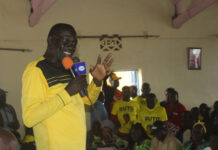Deputy President William Ruto’s campaign strategy is transformational.
In terms of the organisation of electoral politics, Ruto is looking to frame the 2022 election as a fight between dynasties and hustlers. The narrative is that dynasties stand for economic exclusion but the hustlers seek economic inclusion.
This is a paradigm shift from the political schema of shaping electoral politics around ethnic coalitions to achieve a ‘tyranny of numbers’. In that schema, the majority ethnic pool wins the election without a sustained economic message.
Ruto’s bottom-up narrative has fundamentally forced his opponents to address economic issues. Ruto has also shaped his presidential bid in the 2022 elections as one that shuns ethnic conglomerations.
He has chided political alliances as tribal groupings seeking to access power for oligarchs.
The DP says these oligarchs have no interest in the economic inclusion of Kenya’s poorest, whom Ruto calls the hustlers. This is a message that appears to have gained significant traction and raised much disquiet in his opponents’ camps.
An important plank of Ruto’s campaign strategy is to position himself as a politician committed to tackling the politics of ethnic alliances. He is advancing the idea of creating large tent umbrella party politics.
This is a politics of interests coalescing around ideas like “bottom-up” over the oligarchs’ keenness on maintaining a system working for them and not the people.
This drive to create large tent umbrella party politics stems from two advantages he has. The first is his massive war chest in cash to fund a large tent umbrella party. The second is the power of his hustler brand of politics.
This brand of politics has moved the channel of political mobilisation from ethnic identities to economic necessities.
To advance his agenda, Ruto has dealt coercively with political allies such as Moses Kuria of the People’s Empowerment Party and Mwangi Kiunjuri of the Service Party.
Ruto’s strategy is to force allies like Kuria and Kiunjuri to fold their parties and join his United Democratic Alliance. He wants to emphasise to his allies that UDA is their best hope of ever accessing State House in 2022 and that only he is in charge.
What also works in Ruto’s favour is that the One Kenya Alliance, Orange Democratic Movement, Wiper, Amani National Congress, Kenya African National Union and Ford Kenya are hopelessly divided over who should carry the banner for president. To succeed, the anti-Ruto team need to hang together, or they will hang separately.
While Ruto’s campaign strategy is transformational, it faces major challenges. The biggest challenge for Ruto’s campaign strategy is the massive power of the state and its unfathomable depth in election campaign resources.
President Uhuru Kenyatta has openly shown his disdain and opposition to the deputy president. In addition to this, his political foes have a depth of campaign experience they can marshal together to defeat the UDA.
The other challenge Ruto’s campaign strategy faces is the danger that it is peaking too early and there are still 12 months to the 2022 election. Twelve months is an eternity in Kenyan politics. A lot can happen in the interim.
Lastly, Ruto’s campaign strategy has to deal decisively with the divisive nature of the deputy president’s shadowy political past.
He has been associated with corrupt practices that fleeced the state of billions of shillings through his political associates. Will this shadowy past come back to bite him?
What might save his campaign is that corruption among Kenya’s political elite has become normalised. If one political player is perceived as corrupt, it really does not matter because the electorate assumes all political players dabble in graft.
Calling Ruto corrupt can actually become a boost to his political campaign. The more his detractors call him corrupt, the more his popularity and charisma will grow.
The DP is shaping a Robin Hood image of himself as an average Kenyan hustler, who learnt how to outwit a corrupt dynastic status quo that only works for the monied few, but excludes the many, for whom Ruto is fighting.
Ruto’s best bet is to hope the hustler narrative snowballs into a national wave. That the election gets framed as one of the dynastic – haves (minority) on one side, against the hustlers (majority) – have nots on the other.
Ruto will be playing to the politics of economic populism (inclusion) on one side, against the dynasties economic elitism (exclusion) on the other.
There is still a long way to go to August 2022 before a real assessment of how effective Ruto’s campaign strategy has been.
READ ALSO:
- Nandi MPs demand answers on money spent on BBI
- Ruto used Uhuru’s ‘absence’ to gain ground in Mt Kenya
- Three North Rift governors to seek re-election in 2022
- UDA: THE NATIONAL WOMEN CONGRESS (NWC)
- Only two women interested in governorship in North Rift
- Students and young People
- REGISTER TO UDA YOUTH WING









![PakaKumi >> Claim your 2000sh Registration Bonus[2022] PakaKumi](https://www.udayouths.co.ke/wp-content/uploads/2021/09/E8qADwoWQAA2Cqd-100x70.jpg)
